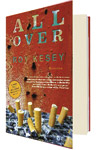Roy Kesey and his press are debuting together. Kesey’s first collection of short fiction is also the first release from Dzanc Books, a new Michigan-based publisher and literary nonprofit. Its various just-launched or ready-to-launch projects include a writers-in-the-schools program for Michigan, a literary award for works-in-progress, and a new imprint. After All Over, Dzanc plans to publish books by Yannick Murphy and Peter Markus, as well as two more by Kesey and a reissue of his novella Nothing in the World (Bullfight Media, 2006). Since their projects are all open ended and designed to grow with time, All Over is an especially good first choice for Dzanc: it is a fast-paced, risk-taking book preoccupied with futurity. Two of the stories (“Cheese” and “Loess”) feature characters who speak freely about things to come—not what they hope or fear may come to pass, but rather what they know is bound to.
In “Blazonry,” a man named Wayne gets a package in the mail but won’t open it because “he knew it was not yet time.” The rest of the story concerns Wayne’s attempts to fill the time until it’s time. He baits his neighbor, slacks off at work, alienates his brother, neglects his mother, and occasionally describes (imagines?) a personal coat of arms: “Crest: On a wreath of the colors, a Gopher guardant proper, vulned Gules at the breast with a Lawn Dart Argent.” As his life goes to hell, the mystery of the unopened package takes on a mystical and monumental significance. The coat of arms, while very funny, isn’t strictly necessary or related to the rest of what’s going on. It lacks the unifying power of a titular thread of narrative, so the story reads like a chocolate sundae topped with a powdered doughnut: just because they’re both rich treats doesn’t mean they belong on the same plate.
Kesey’s plots and his language both tend toward a busyness that is always on the verge of clutter. “Fontanel” seems to have exactly one narrative layer too many—as in “Blazonry,” the excess doesn’t detract, but neither does it add—and “[Exeunt.” opens with a long and stunning paragraph about flaming birds that doesn’t seem to connect to the rest of the story. This small, astonishing gem of prose would have fared better elsewhere as a diamond solitaire rather than as one more pearl on a string.
“Wait,” a...
You have reached your article limit
Sign up for a digital subscription and continue reading all new issues, plus our entire archives, for just $1.50/month.
Already a subscriber? Sign in





